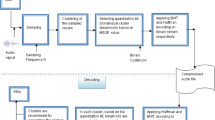Abstract
In this paper, a lossless audio codec with dynamic block coding has been proposed. In the present technique, audio signal is compressed by integrating dynamic sampled value segregation and block coding method without losing any information. Novel block encoding method is performed over the generated dynamic bit sequence of sampled values and followed by eliminating repetitions of bit patterns and entropy encoding. Compression quality is justified with considering decoded audio quality and achieved compression ratio which is compared with existing lossless audio coding benchmarks. The performance measurement of the proposed system comparing with other reference systems is shown considering some crucial qualitative parameters.








Similar content being viewed by others
Data availability
Data sharing not applicable to this article as no datasets were generated or analyzed during the current study.
Abbreviations
- RNN:
-
Recurrent neural network
- PNSR:
-
Peak signal-to-noise ratio
- MPEG:
-
Moving picture experts group
- AAC:
-
Advanced audio coding
- CNN:
-
Convolutional neural network
- MOS:
-
Mean opinion score
- BER:
-
Bit error rate
References
Holtz K, Holtz E (1994) Lossless data compression techniques. Proceedings of WESCON’94. IEEE, New Jersey, pp 392–397
Jayasankar U, Thirumal V, Ponnurangam D (2021) A survey on data compres- sion techniques: from the perspective of data quality, coding schemes, data type and applications. J King Saud Univ-Comput Inform Sci 33(2):119–140
Huffman DA (1952) A method for the construction of minimum-redundancy codes. Proc IRE 40(9):1098–1101
Reznik YA (2004) Coding of prediction residual in mpeg-4 standard for lossless audio coding (mpeg-4 als). 2004 IEEE International Conference on Acoustics, Speech, and Signal Processing, vol 3. IEEE, New Jersey, p 1024
Huang H, Franti P, Huang D, Rahardja S (2008) Cascaded rls–lms prediction in mpeg-4 lossless audio coding. IEEE Trans Audio Speech Lang Process 16(3):554–562
Yu R, Geiger R, Rahardja S, Herre J, Lin X, Huang H (2004) Mpeg-4 scalable to lossless audio coding. In: Proc. 117th AES Conv, pp 1–14
Ghido F, Tabus I (2012) Sparse modeling for lossless audio compression. IEEE Trans Audio Speech Lang Process 21(1):14–28
Gunawan TS, Zain MKM, Muin FA, Kartiwi M (2017) Investigation of lossless audio compression using IEEE 1857.2 advanced audio coding. Indones J Electr Eng Comput Sci 6(2):422–430
Tsai T-H, Tsai F-L (2019) Efficient lossless compression scheme for multi-channel ecg signal. International conference on acoustics, speech and signal processing (ICASSP). IEEE, New Jersey, pp 1289–1292
Hoogeboom E, Peters J, Van Den Berg R, Welling M. (2019) Integer discrete flows and lossless compression. Adv Neural Inform Process Syst 32
Mondal UK, Debnath A (2021) Developing a dynamic cluster quantization based lossless audio compression (dcqlac). Multimed Tools Appl 80(6):8257–8280
Debnath A, Mondal UK (2020) Achieving lossless audio encoder through inte- grated approaches of wavelet transform, quantization and huffman encoding (laeiwqh). In: 2020 International Conference on Computer Science, Engineering and Applications (ICCSEA), pp 1–5
Mondal UK, Debnath A, Mandal J (2020) Deep learning-based lossless audio encoder (dllae). Intelligent computing: image processing based applications. Springer, Cham, pp 91–101
Rim DN, Jang I, Choi H (2021) Deep neural networks and end-to-end learning for audio compression. J KIISE. https://doi.org/10.5626/JOK.2021.48.8.940
Mondal UK, Debnath A (2022) Designing a novel lossless audio compression tech- nique with the help of optimized graph traversal (lacogt). Multimedia Tools Appl 81(28):40385–40411
Hajirahimi Z, Khashei M, Hamadani AZ (2023) Principal component-based hybrid model for time series forecasting. Int J Inf Technol. https://doi.org/10.1007/s41870-023-01343-2
Nafis MT, Biswas R (2019) A secure technique for unstructured big data using clustering method. Int J Inf Technol. https://doi.org/10.1007/s41870-019-00278-x(2019)
Chaurasiya R, Ganotra D (2023) Deep dilated cnn based image denoising. Int J Inf Technol 15(1):137–148
Guerra K, Casavilca J (2023) A low-rate encoder for image transmission using lora communication modules. Int J Inf Tecnol 15(2):1069–1079
Gupta S, Yadav AK, Yadav D, Shukla B (2022) A scalable approach for index compression using wavelet tree and lzw. Int J Inf Tecnol 14(4):2191–2204
https://monkeysaudio.com/index.html. Accessed: 15 Sept 2023
http://www.wavpack.com. Accessed 15 Sept 2023
Coalson J. Xiph. Org Foundation, “FLAC: Free lossless audio codec”. https://xiph.org/flac/index.html. Accessed 15 Sept 2023
Nowak N, Zabierowski W, (2011) Methods of sound data compression—comparison of different standards. In: The Experience of Designing and Application of CAD Systems in Microelectronics (CADSM), pp 431–434
Mineo T, Shouno H (2022) A lossless audio codec based on hierarchical residual prediction. 2022 Asia-Pacific signal and information processing association annual summit and conference (APSIPA ASC). IEEE, New Jersey, pp 123–130
https://www.freac.org/downloads-mainmenu-33/350-freac-114. Accessed 21 Sept 2023
Author information
Authors and Affiliations
Contributions
The authors confirm the responsibility for the following: study conception, data collection, analysis and interpretation of results and manuscript preparation.
Corresponding author
Ethics declarations
Conflict of interest
All author certify that they have no affiliation with or involvement in any organization or entity with any financial interest or nonfinancial interest in the subject matter or materials discussed in this manuscript.
Rights and permissions
Springer Nature or its licensor (e.g. a society or other partner) holds exclusive rights to this article under a publishing agreement with the author(s) or other rightsholder(s); author self-archiving of the accepted manuscript version of this article is solely governed by the terms of such publishing agreement and applicable law.
About this article
Cite this article
Debnath, A., Mondal, U.K. Lossless audio CODEC using non-repeated dynamic block encoding. Int. j. inf. tecnol. (2024). https://doi.org/10.1007/s41870-024-01785-2
Received:
Accepted:
Published:
DOI: https://doi.org/10.1007/s41870-024-01785-2




